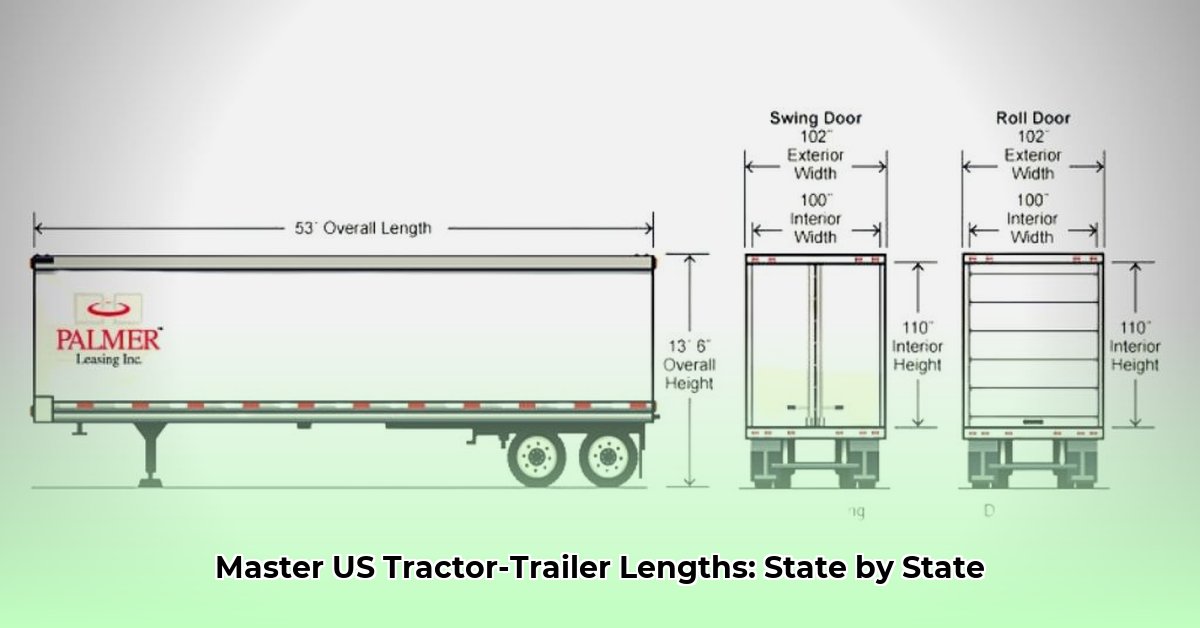
Navigating the complex regulations governing the length of tractor-trailers in the US can be challenging. This guide provides a state-by-state overview, actionable steps for compliance, and strategies for efficient long-haul transportation. For more detailed information, see this helpful resource: Tractor Trailer Length Guide.
Understanding Federal and State Regulations
Federal regulations establish minimum length requirements for interstate trucking, ensuring a baseline standard across the nation. However, individual states determine their own maximum lengths, creating a patchwork of rules that truckers must navigate. This variability impacts route planning, permitting, and overall operational efficiency. Failure to comply can result in significant fines and delays.
Key Considerations:
- Federal Minimums: The federal government sets minimum length standards for interstate commerce; these are generally not restrictive.
- State-Specific Maximums: Each state establishes its own legal maximum length for tractor-trailers, often varying significantly.
- Oversized Load Permits: Hauling loads exceeding state maximums requires obtaining special permits; these processes vary widely across states.
- Route Planning: Careful route planning is essential to ensure compliance with all applicable state regulations.
State-by-State Length Variations: A Summary
Below is a sample of state regulations. Always consult the official websites of individual state Departments of Transportation (DOT) for the most up-to-date information. Regulations are subject to change.
| State | Maximum Trailer Length (feet) | Notes |
|---|---|---|
| California | 53 | Common maximum length in many states. |
| Texas | Up to 75 (with permits) | Longer lengths often permissible with proper permits and route planning. |
| Oklahoma | Up to 75 (with permits) | Similar to Texas. |
| Pennsylvania | 48 | One of the more restrictive states. |
| Arizona | 53 | Standard length for many routes. |
| (Note: This table presents a small selection of states and is not exhaustive.) |
Actionable Steps for Compliance
To avoid legal issues and operational disruptions, follow these steps:
- Pre-Trip Route Planning: Before each trip, meticulously plan your route, consulting each state's DOT website to verify current length restrictions (e.g., Arizona DOT Website, Texas DOT Website). Consider using GPS systems specifically designed for commercial vehicles.
- Permit Acquisition: If your load exceeds a state's length limits, immediately apply for the necessary oversize/overweight permit(s) well in advance of your departure. Delays in processing applications can impact scheduling.
- Driver Training: Thoroughly train all drivers on state-specific size regulations, permit requirements, and safe handling of oversized loads. A well-trained driver is a safer driver and reduces liability.
- Continuous Monitoring: Regulations frequently change. Establish a routine for regularly reviewing updates from the Federal Highway Administration (FHWA) and specific state DOTs.
- Documentation Maintenance: Maintain thorough records of permits, route plans, and any other relevant documentation to demonstrate compliance. Keeping organized records is crucial in case of an inspection.
Obtaining Oversize/Overweight Permits: A Detailed Guide
Securing oversize/overweight permits can seem daunting, but a systematic approach minimizes complications.
- Accurate Load Measurement: Precisely measure your cargo's dimensions (length, width, height, and weight). Inaccurate measurements can lead to permit rejection or legal issues.
- Route Selection: Choose your route carefully, considering state-specific restrictions and potential route challenges for oversized loads. Some routes may be prohibited entirely.
- State-Specific Research: Thoroughly research each state's DOT website to understand its permit application process (requirements, fees, etc.).
- Application Completion: Complete the permit application accurately and comprehensively. Omissions or inaccuracies can result in delays or rejection.
- Fee Payment: Pay all applicable fees promptly.
- Escort Vehicle Requirements: Determine if escort vehicles are required and arrange for them accordingly.
- Confirmation & Travel: Once approval is received, confirm your permit details and proceed with your trip, adhering to all speed limits and regulations.
Disclaimer: This guide offers informational support and does not constitute legal advice. Always consult official sources for the most up-to-date and accurate regulations. Non-compliance can result in substantial fines and legal penalties. Safety and legality are paramount.